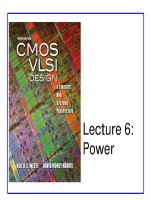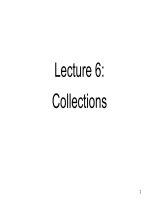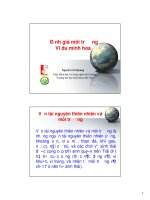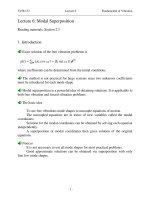lecture 6 gc
Bạn đang xem bản rút gọn của tài liệu. Xem và tải ngay bản đầy đủ của tài liệu tại đây (231.71 KB, 5 trang )
GAS CHROMATOGRAPHY
GAS CHROMATOGRAPHY
PHAM VAN HUNG, PhD
PHAM VAN HUNG, PhD
Function
Function
Separation of volatile organic compounds
Separation of volatile organic compounds
Volatile
Volatile
–
–
when heated,
when heated,
VOCs
VOCs
undergo a phase
undergo a phase
transition into intact gas
transition into intact gas
-
-
phase species
phase species
Separation occurs as a result of unique
Separation occurs as a result of unique
equilibria
equilibria
established between the solutes and the
established between the solutes and the
stationary phase (the GC column)
stationary phase (the GC column)
An inert carrier gas carries the solutes through
An inert carrier gas carries the solutes through
the column
the column
Application
Uses
Separation and analysis of organic compounds
Testing purity of compounds
Determine relative amounts of components in mixture
Compound identification
Isolation of pure compounds (microscale work)
Similar to column chromatography, but differs in 3 ways:
Partitioning process carried out between Moving Gas Phase
and Stationary Liquid Phase
Temperature of gas can be controlled
Concentration of compound in gas phase is a function of
the vapor pressure only.
GC also known as Vapor-Phase Chromatography (VPC) and
Gas-Liquid Partition Chromatography
(GLPC).
Filters/Traps
Air
Hydrogen
Gas Carrier
Column
Components
Components
gas system
gas system
inlet
inlet
column
column
detector
detector
data system
data system
Data system
Syringe/Sampler
Inlets
Detectors
Regulators
H
RESET
Schematic Diagram of Gas Chromatography
Carrier Gas
Carrier Gas
-
-
Supply
Supply
Carrier gases, which must be chemically inert,
Carrier gases, which must be chemically inert,
include helium, nitrogen, and hydrogen.
include helium, nitrogen, and hydrogen.
Associated with the gas supply are pressure
Associated with the gas supply are pressure
regulators, gauges, and flow meters. In addition,
regulators, gauges, and flow meters. In addition,
the carrier gas system often contains a molecular
the carrier gas system often contains a molecular
sieve to remove water or other impurities.
sieve to remove water or other impurities.
Must be at a constant flow rate so that retention
Must be at a constant flow rate so that retention
times & retention volumes may be equated
times & retention volumes may be equated
Injector
Injector
A GC syringe penetrates a septum to inject
A GC syringe penetrates a septum to inject
sample into the vaporization camber
sample into the vaporization camber
Instant vaporization of the sample, 280
Instant vaporization of the sample, 280
°
°
C
C
Carrier gas transports the sample into the head
Carrier gas transports the sample into the head
of the column
of the column
Purge valve controls the fraction of sample that
Purge valve controls the fraction of sample that
enters the column
enters the column
Split or
Split or
splitless
splitless
Usually operated in split mode unless sample
Usually operated in split mode unless sample
limited
limited
Chromatographic resolution depends upon the
Chromatographic resolution depends upon the
width of the sample plug
width of the sample plug
In
In
splitless
splitless
mode the purge valve is close for 30
mode the purge valve is close for 30
-
-
60 s, which means the sample plug is 30
60 s, which means the sample plug is 30
-
-
60
60
seconds
seconds
As we will see, refocusing to a more narrow
As we will see, refocusing to a more narrow
sample plug is possible with temperature
sample plug is possible with temperature
programming
programming
Column Configurations
Column Configurations
Two general types of columns are encountered
Two general types of columns are encountered
in gas chromatography,
in gas chromatography,
packed
packed
and
and
open
open
tubular
tubular
, or
, or
capillary
capillary
.
.
Chromatographic columns vary in length from
Chromatographic columns vary in length from
less than 2 m to 50 m or more. They are
less than 2 m to 50 m or more. They are
constructed of stainless steel, glass, fused silica,
constructed of stainless steel, glass, fused silica,
or Teflon. In order to fit into an oven for
or Teflon. In order to fit into an oven for
thermostating
thermostating
, they are usually formed as coils
, they are usually formed as coils
having diameters of 10 to 30 cm.
having diameters of 10 to 30 cm.
Columns
Columns
• Packed
• Capillary
0.32 mm ID
Liquid
Stationary
phase
Mobile phase
(Helium)
flowing at 1
mL/min
Open Tubular Capillary Column
Open Tubular Capillary Column
15-60 m in length
0.1-5 μm
Polar vs.
Polar vs.
nonpolar
nonpolar
Separation is based on the vapor pressure and
Separation is based on the vapor pressure and
polarity of the components.
polarity of the components.
Within a homologous series (
Within a homologous series (
alkanes
alkanes
, alcohol,
, alcohol,
olefins, fatty acids) retention time increases with
olefins, fatty acids) retention time increases with
chain length (or molecular weight)
chain length (or molecular weight)
Polar columns retain polar compounds to a
Polar columns retain polar compounds to a
greater extent than non
greater extent than non
-
-
polar
polar
C18 saturated vs. C18 saturated methyl ester
C18 saturated vs. C18 saturated methyl ester
C16:0
C18:0
C18:1
C18:2
C16:1
C16:0
C18:0
C18:1
C18:2
C16:1
RT (min)
RT (min)
Polar column
Non-polar column
Oven
Oven
Programmable
Programmable
Isothermal
Isothermal
-
-
run at one constant temperature
run at one constant temperature
Temperature programming
Temperature programming
-
-
Start at low
Start at low
temperature and gradually ramp to higher
temperature and gradually ramp to higher
temperature
temperature
More constant peak width
More constant peak width
Better sensitivity for components that are retained
Better sensitivity for components that are retained
longer
longer
Much better chromatographic resolution
Much better chromatographic resolution
Peak refocusing at head of column
Peak refocusing at head of column
Typical Temperature Program
Typical Temperature Program
Time (min)
0
60
50°C
220°C
160°C
Detection Systems
Detection Systems
Characteristics of the Ideal Detector:
Characteristics of the Ideal Detector:
The
The
ideal detector for gas chromatography has the
ideal detector for gas chromatography has the
following characteristics:
following characteristics:
1. Adequate sensitivity
1. Adequate sensitivity
2. Good stability and reproducibility.
2. Good stability and reproducibility.
3. A linear response to solutes that extends over
3. A linear response to solutes that extends over
several orders of magnitude.
several orders of magnitude.
4. A temperature range from room temperature
4. A temperature range from room temperature
to at least 400
to at least 400
o
o
C.
C.
Characteristics of the Ideal Detector
Characteristics of the Ideal Detector
5. A short response time that is independent of
5. A short response time that is independent of
flow rate.
flow rate.
6. High reliability and ease of use.
6. High reliability and ease of use.
7. Similarity in response toward all solutes or a
7. Similarity in response toward all solutes or a
highly selective response toward one or more
highly selective response toward one or more
classes of solutes.
classes of solutes.
8. Nondestructive of sample.
8. Nondestructive of sample.
Detectors
Detectors
Flame Ionization Detectors (FID)
Flame Ionization Detectors (FID)
Electron Capture Detectors (ECD)
Electron Capture Detectors (ECD)
Electron impact/chemical ionization (EI/CI)
Electron impact/chemical ionization (EI/CI)
Mass spectrometry
Mass spectrometry
FIDs
FIDs
Effluent exits column and enters an
Effluent exits column and enters an
air/hydrogen flame
air/hydrogen flame
The gas
The gas
-
-
phase solute is
phase solute is
pyrolized
pyrolized
to form
to form
electrons and ions
electrons and ions
All carbon species are reduced to CH
All carbon species are reduced to CH
2
2
+
+
ions
ions
These ions collected at an electrode held above
These ions collected at an electrode held above
the flame
the flame
The current reaching the electrode is amplified
The current reaching the electrode is amplified
to give the signal
to give the signal
FID
FID
A general detector for organic compounds
A general detector for organic compounds
Very sensitive (10
Very sensitive (10
-
-
13
13
g/s
g/s
)
)
Linear response (10
Linear response (10
7
7
)
)
Rugged
Rugged
Disadvantage: specificity
Disadvantage: specificity
ECD
ECD
Ultra
Ultra
-
-
sensitive detection of halogen
sensitive detection of halogen
-
-
containing
containing
species
species
Pesticide analysis
Pesticide analysis
Other detectors besides MS
Other detectors besides MS
IR
IR
AE
AE
SEMI- QUANTITATIVE ANALYSIS OF FATTY ACIDS
C
C
C
Detector Response
Retention Time
14
16
18
Peak Area (cm )
Sample Concentration (mg/ml)
2
4
6
8
10
0.5 1.0
1.5
2.0 2.5
3.0
2
The content % of C fatty acids =
C
C + C + C
100
∗
14
1816
14
= the content % of C fatty acids
14
14
TENTATIVE IDENTIFICATION OF UNKNOWN COMPOUNDS
Response
GC Retention Time on Carbowax-20 (min)
Mixture of known compounds
Hexane
Octane
Decane
1.6 min = RT
Response
Unknown compound may be Hexane
1.6 min = RT
Retention Time on Carbowax-20 (min)
Response
GC Retention Ti me on SE-30
Unknown compound
RT= 4 min on SE-30
Response
GC Retention Ti me on SE-30
Hex an e
RT= 4.0 min on SE-30
Retention Times
GLC ADVANTAGES
1. Very good separation
2. Time (analysis is short)
3. Small sample is needed - μl
4. Good detection system
5. Quantitatively analyzed
DISADVANTAGES OF GAS CHROMATOGRAPHY
Material has to be volatilized at 250C without decomposition.
R C OH CH
3
OH H
2
SO
4
O
R C O CH
3
O
CH
2
O C R
CH O C R
CH
2
O C R
O
O
O
CH
3
OH
O
R C O CH
3
CH
3
ONa
Fatty Acids
Methylester
Reflux
+
3
Volatile in Gas
Chromatography
Volatile in Gas
Chromatography
++
Gas Chromatogram of Methyl Esters of Fatty Acids









